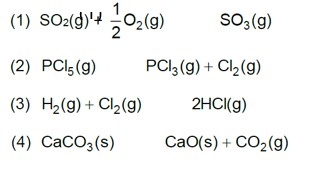7.32. Predict which of the following will have appreciable concentration of reactants and products:
a) Cl2 (g) ⇌2Cl (g) Kc = 5 ×10–39
b) Cl2 (g) + 2NO (g) ⇌2NOCl (g) Kc = 3.7 × 108
c) Cl2 (g) + 2NO2 (g) ⇌2NO2Cl (g) Kc = 1.8
7.32. Predict which of the following will have appreciable concentration of reactants and products:
a) Cl2 (g) ⇌2Cl (g) Kc = 5 ×10–39
b) Cl2 (g) + 2NO (g) ⇌2NOCl (g) Kc = 3.7 × 108
c) Cl2 (g) + 2NO2 (g) ⇌2NO2Cl (g) Kc = 1.8
-
1 Answer
-
Following conclusions can be drawn from the values of Kc .
(a) Since the value of Kc is very small, this means that the molar concentration of the products is very small as compared to that of the reactants.(b) Since the value of Kc is quite large, this means that the molar concentration of the products is very large as compared to that of the reactants.
(c) Since the value of Kc is 1.8, this means that both the products and reactants have appreciable concentration.
Similar Questions for you
0.01 M NaOH,
M = 1 * 10-2

pOH = 2
pH = 2
Kp = Kc (RT)Dng
36 * 10–2 = Kc (0.0821 * 300)–1
Kc = 0.36 * 0.0821 * 300 = 8.86 » 9
A(g) ->B(g) + (g)
Initial moles n 0 0
Eqb. moles n(1 – a) na
total moles =
Eqb. pressure
On increasing pressure, equilibrium moves in that direction where number of gaseous moles decreases.
Taking an Exam? Selecting a College?
Get authentic answers from experts, students and alumni that you won't find anywhere else
Sign Up on ShikshaOn Shiksha, get access to
- 65k Colleges
- 1.2k Exams
- 679k Reviews
- 1800k Answers


